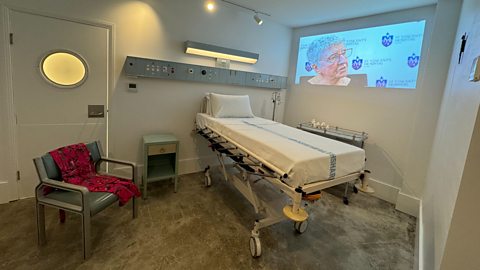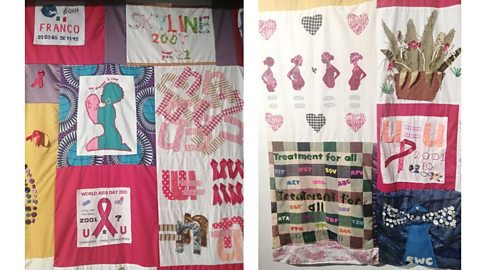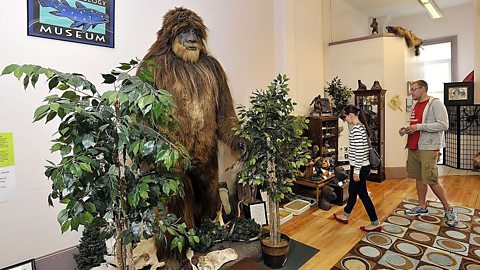When the first World Aids Day was held in 1988, its aim was to raise awareness about HIV and Aids as well as acknowledging the people who had been affected by the virus and its related illnesses.
More than 30 years later, advances in medical research have created effective treatment for HIV, and work continues to find a cure. But the news around HIV has not always been positive. In the early days of the epidemic, when little information was available, those affected by the virus held protests against the way society was treating them, and to call for more empathy, understanding and education surrounding the condition.
ItÔÇÖs now possible to see evidence of this period in our recent history in museums around the UK and beyond. │╔╚╦┐ì╩Í Bitesize takes a look at a few examples.
Museum of Liverpool: Fight the fear with facts
In the late 1980s, there was an official government campaign which aimed to stop Aids and HIV from spreading. It used the hard-hitting slogan DonÔÇÖt Die of Ignorance, encouraging people to take precautions and have sex safely without potentially passing on the virus.
At around the same time, a graphic designer in his early 20s called Andrew Dineley was working for the NHS in Liverpool as part of a team that wanted to spread information about Aids and HIV in a different way.
Andrew told Bitesize: ÔÇ£What we wanted to do was soften the message, so that more people could relate to it and they werenÔÇÖt frightened. We wanted to fight the fear with facts.ÔÇØ
 Image source, Pete Carr
Image source, Pete CarrThe approach led to the creation of a leaflet that presented details of helplines which people could call to get support over issues related to the Aids crisis. It was a resource that also aimed to combat some of the stigma surrounding the virus and its stereotypes about the LGBTQ+ community in particular.
ÔÇ£We had very little money,ÔÇØ Andrew explained, ÔÇ£and we were given The complete freedom to act as you wish. In French, it means 'blank document' - as in an agreement between two people. One person signs their permission and the other person fills in the details of the agreement later. to do it.ÔÇØ He continued: ÔÇ£I remember we just came up with ÔÇİfight the fear with factsÔÇÖ in about 20 minutes, just having a conversation.ÔÇØ
Despite the speed in which the project was put together, it had the sort of impact campaigns with greater development time aim to achieve, and it caught on nationally. Andrew said getting the positive feedback was lovely and perhaps unusual for public health design work, but one thing stood out: "I remember a conversation with someone about 10 years ago. He said to me that those resources probably saved his life and I remember thinking, ÔÇİoh my goshÔÇÖ.
ÔÇ£He said how they were all over university when he was a student and just coming out. He said it was these resources where he was learning about the subject, that he would have been a bit afraid to look at in a newspaper. All this was happening because of the stigma attached to it.ÔÇØ
Leaflets, stickers and badges from ÔÇİFight the fear with factsÔÇÖ are currently on display at the Museum of LiverpoolÔÇÖs The Holly Johnson Story.
Qtopia Sydney: Ward 17 South
Aids was very much in the public eye in the 1980s and some patients reported unsympathetic treatment at hospitals due to the stigma surrounding their condition.
In Qtopia Sydney, a museum in Australia which focuses on LGBTQ+ life and issues, the exhibit Ward 17 South takes a look at a place which aimed to do things differently for patients with HIV and Aids-related illnesses.

Ward 17 South opened in St VincentÔÇÖs Hospital, Sydney in 1984 and was the first dedicated treatment and care centre for people with HIV and Aids in the country. The staff made it clear from the beginning that anyone with HIV would feel welcome and safe in the centre, without any judgement.
Professor Anthony Schembri, who now has a high-ranking role at St VincentÔÇÖs, began his career as a social worker on Ward 17. On World Aids Day 2019, he said in an speech how his first patient there was seriously ill and his family no longer wanted anything to do with him, but staff at St VincentÔÇÖs promised him that he wouldnÔÇÖt be alone.
A recreation of Ward 17 is on display at Qtopia, and includes interviews and images reflecting the time between the early 1980s and 2007, when Ward 17 South closed.
Irish Museum of Modern Art: Aids is Not Over
When the Aids crisis was first identified in the early 1980s, some groups of people in society were considered more vulnerable to HIV and Aids-related illnesses than others and were not always viewed sympathetically. This included LGBTQ+ people, who led many protests about the way they were treated during the epidemic.
On the first World Aids Day in 1988, members of a protest group called ACT UP (Aids Coalition to Unleash Power) released 1,000 balloons in London to mark the approximate number of people who had been diagnosed with Aids in the previous year. ACT UP began in the USA, but its British group protested about the way Aids sufferers were portrayed in the media and carried out large marches on the Houses of Parliament, among other events.
 Image source, Breda Lynch
Image source, Breda LynchA similar protestor is featured in an exhibition at DublinÔÇÖs Irish Museum of Modern Art, as part of a series of works by the artist Breda Lynch called Fragments of a Lost Civilisation. This particular image shows a protestor holding up a placard which reads ÔÇİAids is Not OverÔÇÖ and is dated 2016.
Homosexuality was decriminalised in England and Wales in 1967, in 1981 in Scotland and 1982 in Northern Ireland. It was 1993 when the same thing happened in Ireland, although during the Aids crisis, a group called GHA (Gay Health Action) formed in 1985 to spread information and education about HIV and Aids.
LynchÔÇÖs image is cyanotype, made using light-sensitive paper. The technique does not require a camera and was one of the earliest methods of photography.
Thackray Museum of Medicine: Aids Memorial Quilt
In the 1980s, memorial quilts became a tradition for people who wanted to show their respect to a friend or loved one who had died due to the Aids epidemic.
The idea began in San Francisco, USA, a city with a large LGBTQ+ population and came from Cleve Jones, an author and human rights activist. When Jones asked marchers taking part in a candlelight vigil to write the names of those they loved who had died on placards, the signs were later placed together on the walls of the cityÔÇÖs Federal Building.
 Image source, Thackray Museum of Medicine
Image source, Thackray Museum of MedicineThe collective placards looked like a patchwork quilt, and this inspired a community arts project which is ongoing today. Instead of cardboard signs, people were asked to provide a sewn panel, dedicated to a loved one, which could form part of a quilt. The US quilts were first displayed in Washington DC in October 1987 - today they feature roughly 50,000 panels dedicated to more than 110,00 people and weigh more than 50 tonnes.
Memorial quilts were adopted in other countries, including the UK. The Thackray Museum of Medicine in Leeds has two in its collection donated by the charity Leeds Skyline, which supports people affected by HIV in the city. The one pictured features 22 panels and was made in 2021, to mark 40 years since the fight against Aids and HIV began.
This article was published in November 2024
Looking for quizzes, amazing stories and fun facts?
Bitesize Topical has it all!

Five of the worldÔÇÖs most unusual museums
The collections which focus on legendary creatures, pigs, espionage - and poo

Four LGBT+ plays and musicals that left a lasting impression
From The Boys in the Band to Fun │╔╚╦┐ì╩Í, Rent to The Prom, │╔╚╦┐ì╩Í Bitesize explores some of the most influential LGBT+ plays and musicals in theatre history.

The LGBT icons you need to know about
They took a stand in an attempt to bring about change.
